Traditional Knowledge of the Utilization of Edible Insects in Nagaland, North-East India
Abstract
1. Introduction
2. Materials and Methods
2.1. Study Area
2.2. Data Collection
3. Results and Discussion
3.1. Edible Insects in Nagaland
3.2. Consumption of Edible Insects
3.2.1. Order Odonata
3.2.2. Order Orthoptera
Grasshoppers and Katydids
Crickets
3.2.3. Order Mantodea and Isoptera
3.2.4. Order Hemiptera
Stinkbugs
Aquatic Hemiptera
Cicadas
3.2.5. Order Coleoptera
Wood and Timber Larvae
Aquatic Beetles
Scarab Beetles
3.2.6. Order Hymenoptera
3.2.7. Order Lepidoptera
3.2.8. Order Diptera
4. Rearing and Marketing of Edible Insects
5. Conclusions and Recommendations
Supplementary Materials
Author Contributions
Funding
Acknowledgments
Conflicts of Interest
References
- Tilman, D.; Balzer, C.; Hill, J.; Befort, B.L. Global food demand and the sustainable intensification of agriculture. Proc. Natl. Acad. Sci. USA 2011, 108, 20260–20264. [Google Scholar] [CrossRef] [PubMed]
- Meyer-Rochow, V.B. Therapeutic arthropods and other, largely terrestrial, folk-medicinally important invertebrates: A comparative survey and review. J. Ethnobiol. Ethnomed. 2017, 13, 9. [Google Scholar] [CrossRef] [PubMed]
- Shelomi, M. Why we still don’t eat insects: Assessing entomophagy promotion through a diffusion of innovations framework. Trends Food Sci. Technol. 2015, 45, 311–318. [Google Scholar] [CrossRef]
- Durst, P.B.; Johnson, D.V.; Leslie, R.; Shono, K. Edible Forest Insects-Humans Bite Back; FAO Publication: Bangkok, Thailand, 2010. [Google Scholar]
- Meyer-Rochow, V.B. Can insects help to ease the problem of world food shortage? Search 1975, 6, 261–262. [Google Scholar]
- Van Huis, A.; Van Itterbeeck, J.; Klunder, H.; Mertens, E.; Halloran, A.; Muir, G.; Vantomme, P. Edible Insects: Future Prospects for Food and Feed Security; Food and Agricultural Organisation of the United Nations: Rome, Italy, 2013; pp. 1–190. [Google Scholar]
- Van Huis, A.; Dicke, M.; Van Loon, J.J.A. Insects to feed the world. J. Insects Food Feed 2015, 1, 3–5. [Google Scholar] [CrossRef]
- Costa-Neto, E.M.; Dunkel, F.V. Insects as food: History, culture and modern use around the world. In Insects as Sustainable Food Ingredients; Dossey, A.T., Morales-Ramos, J.L., Rojas, M.G., Eds.; Elsevier: San Diego, CA, USA, 2016; pp. 29–60. [Google Scholar]
- Jongema, Y. List of Edible Insects of the World; Wageningen UR: Wageningen, The Netherlands, 2015; Available online: https://tinyurl.com/mestm6p (accessed on 10 May 2020).
- Mitsuhashi, J. Edible Insects of the World; CRC Press: Boca Raton, FL, USA, 2016. [Google Scholar] [CrossRef]
- Bernard, T.; Womeni, H.M. Entomophagy: Insects as food. In Insect Physiology and Ecology; Shields, V.D.C., Ed.; InTechOpen, Agricultural and Biological Sciences: London, UK, 2017; pp. 233–249. [Google Scholar] [CrossRef]
- Seni, A. Edible insects: Future prospects for dietary regimen. Int. J. Curr. Microbiol. Appl. Sci. 2017, 6, 1302–1314. [Google Scholar] [CrossRef]
- Alexander, P.; Brown, C.; Arneth, A.; Dias, C.; Finnigan, J.; Moran, D.; Rounsevell, M. Could consumption of insects, cultured meat or imitation meat reduce global agricultural land use? Glob. Food Secur. 2017, 15, 22–32. [Google Scholar] [CrossRef]
- Sere, A.; Bougma, A.; Ouilly, J.T.; Traore, M.; Sangare, H.; Lykke, A.M.; Ouedraogo, A.; Gnankine, O.; Bassole, I.H.N. Traditional knowledge regarding edible insects in Burkina Faso. J. Ethnobiol. Ethnomed. 2018, 14, 1–11. [Google Scholar] [CrossRef]
- Hutton, J.H. The Angami Nagas: With Some Notes on Neighbouring Tribes; Macmillan: London, UK, 1921. [Google Scholar]
- Hutton, J.H. The Sema Nagas; Macmillan: London, UK, 1921. [Google Scholar]
- Mills, J.P. The Lhota Nagas; Macmillan: London, UK, 1922. [Google Scholar]
- Mills, J.P. The Ao Nagas; Macmillan: London, UK, 1926. [Google Scholar]
- Meyer-Rochow, V.B.; Changkija, S. Uses of insects as human food in Papua New Guinea, Australia and North-East India: Cross-cultural considerations and cautious conclusions. Ecol. Food Nutr. 1997, 36, 159–185. [Google Scholar] [CrossRef]
- Ao, A.; Singh, H.K. Utilization of insects as human food in Nagaland, India. J. Entomol. 2004, 66, 308–310. [Google Scholar]
- Singson, L.; Das, A.N.; Ahmed, R. Edible insects of Nagaland and its nutritional benefit. Periodic Res. 2016, 5, 1–7. [Google Scholar]
- Pongener, A.; Ao, B.; Yenisetti, S.C.; Lal, P. Ethnozoology and entomophagy of ao tribe in the district of Mokokchung, Nagaland. Ind. J. Tradit. Knowl. 2019, 18, 508–515. [Google Scholar]
- Mozhui, L.; Kakati, L.N.; Changkija, S. A study on the use of insects as food in seven tribal communities in Nagaland, Northeast India. J. Human Ecol. 2017, 60, 42–53. [Google Scholar] [CrossRef]
- Changkija, S. Biodiversity of Nagaland; Department of Forest, Ecology, Environment and Wildlife: Nagaland, India, 2014.
- Kuotsuo, R.; Chatterjee, D.; Deka, B.C.; Kumar, R.; Ao, M.; Vikramjeet, K. Shifting cultivation: An ‘organic like’ farming in Nagaland. Indian J. Hill Farm. 2014, 27, 23–28. [Google Scholar]
- Ghosh, S.; Jung, C.; Meyer-Rochow, V.B. What governs selection and acceptance of edible insect species? In Edible Insects in Sustainable Food Systems; Halloran, A., Vantomme, P., Roos, N., Eds.; Springer: Cham, Switzerland, 2018; pp. 331–351. [Google Scholar]
- Meyer-Rochow, V.B. Food taboos: Their origins and purposes. J. Ethnobiol. Ethnomed. 2009, 5, 18. [Google Scholar] [CrossRef]
- Müller, A. Insects as food in Laos and Thailand: A case of “Westernisation”? Asian J. Soc. Sci. 2019, 47, 204–223. [Google Scholar] [CrossRef]
- Ramos-Elorduy, J. Anthropo-entomophagy: Culture, evolution and sustainability. Entomol. Res. 2009, 39, 271–288. [Google Scholar] [CrossRef]
- Belluco, S.; Losasso, C.; Maggioletti, M.; Alonzi, C.C.; Paoletti, M.G.; Ricci, A. Edible insects in a food safety and nutritional perspective: A critical review. Compr. Rev. Food Sci. Food Saf. 2013, 12, 296–313. [Google Scholar] [CrossRef]
- Testa, M.; Stillo, M.; Maffei, G.; Andriolo, G.; Gardois, P.; Zotti, C.M. Ugly but tasty: A systematic review of possible human and animal health risks related to entomophagy. Crit. Rev. Food Sci. Nutr. 2016, 57, 3734–3759. [Google Scholar] [CrossRef]
- Oonincx, D.G.A.B.; de Boer, J.M. Environmental impact of the production of mealworms as a protein source for humans—A lifecycle assessment. PLoS ONE 2012, 7, e51145. [Google Scholar] [CrossRef]
- Gahukar, R.T. Edible insects collected from forests for family livelihood and wellness of rural communities—A review. Glob. Food Sec. 2020. [Google Scholar] [CrossRef]
- Chakravorty, J.; Ghosh, S.; Megu, K.; Jung, C.; Meyer-Rochow, V.B. Nutritional and anti-nutritional composition of Oecophylla smaragdina (Hymenoptera: Formicidae) and Odontotermes sp. (Isoptera: Termitidae): Two preferred edible insects of Arunachal Pradesh, India. J. Asia-Pacif. Entomol. 2016, 19, 711–720. [Google Scholar] [CrossRef]
- Aochen, C.; Krishnappa, R.; Firake, D.M.; Pyngrope, S.; Aochen, S.; Ningombam, A.; Behere, G.T.; Ngachan, S.V. Loungu (Carpenter worm): Indigenous delicious insects with immense dietary potential in Nagaland state, India. Ind. J. Trad. Knowl. 2020, 19, 145–151. [Google Scholar]
- Nagagaki, B.J.; Defoliart, G.R. Comparison of diets for mass-rearing Acheta domesticus (Orthoptera: Gryllidae) as a novelty food, and comparison of food conversion efficiency with values reported for livestock. J. Econ. Entomol. 1991, 84, 891–896. [Google Scholar] [CrossRef]
- Baek, M.; Yoon, Y.I.; Kim, M.; Hwang, J.S.; Goo, T.W.; Yun, E.Y. Physical and sensory evaluation of Tenebrio molitor larvae coked by various cooking methods. Korean J. Food Cook. Sci. 2015, 31, 534–543. [Google Scholar] [CrossRef]
- Halloran, A.; Caparros Megido, R.; Oloo, J.; Weigel, T.; Nsevolo, P.; Francis, F. Comparative aspect of cricket framing in Thailand, Cambodia, Lao People’s Democratic Republic, Democratic Republic of the Congo, and Kenya. J. Insects Food Feed 2018, 4, 101–114. [Google Scholar] [CrossRef]
- Hanboonsong, Y.; Durst, P.B. Edible insects. In Lao PDR: Building on Tradition to Enhance Food Security; FAO: Bangkok, Thailand, 2014; pp. 1–55. [Google Scholar]
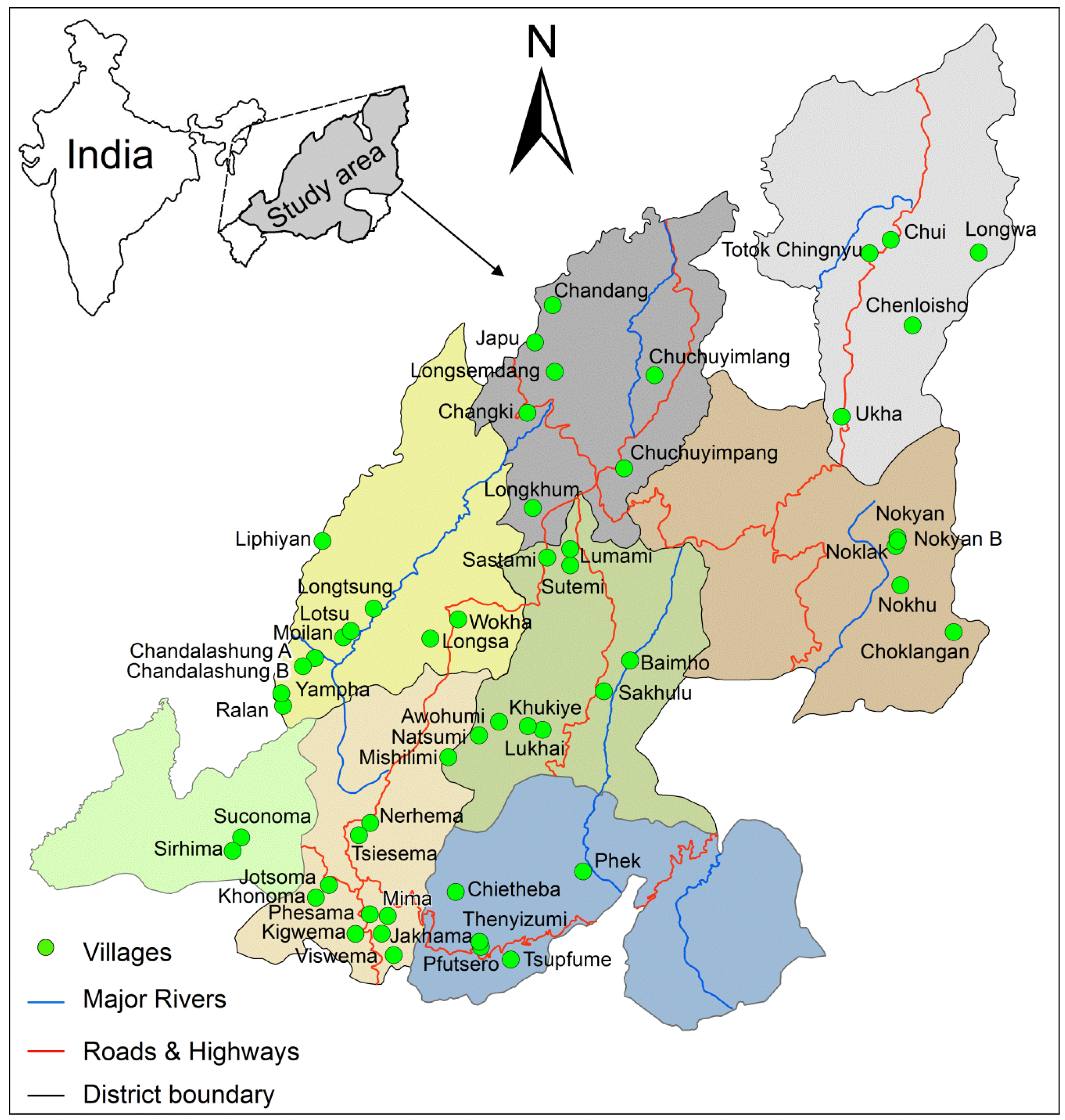
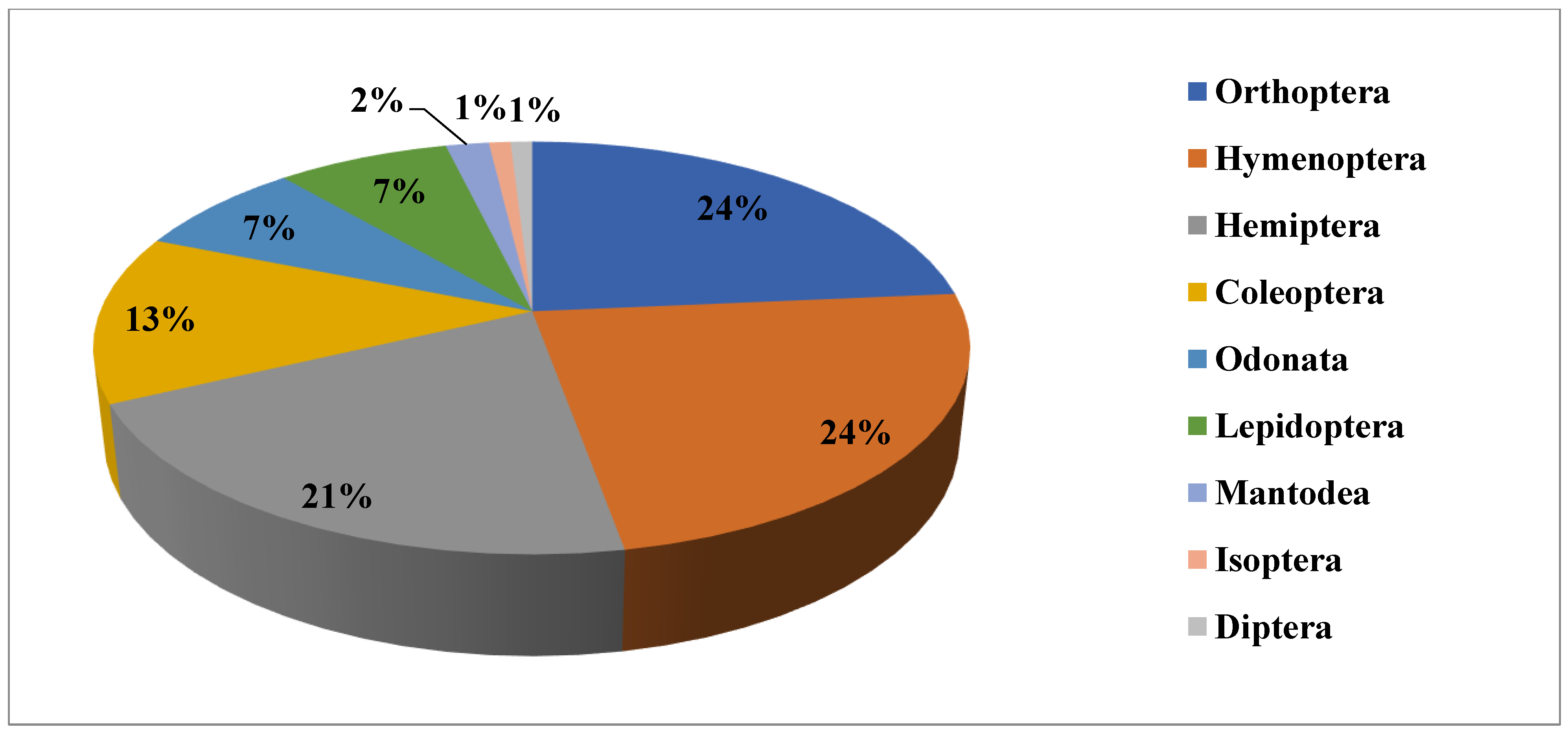



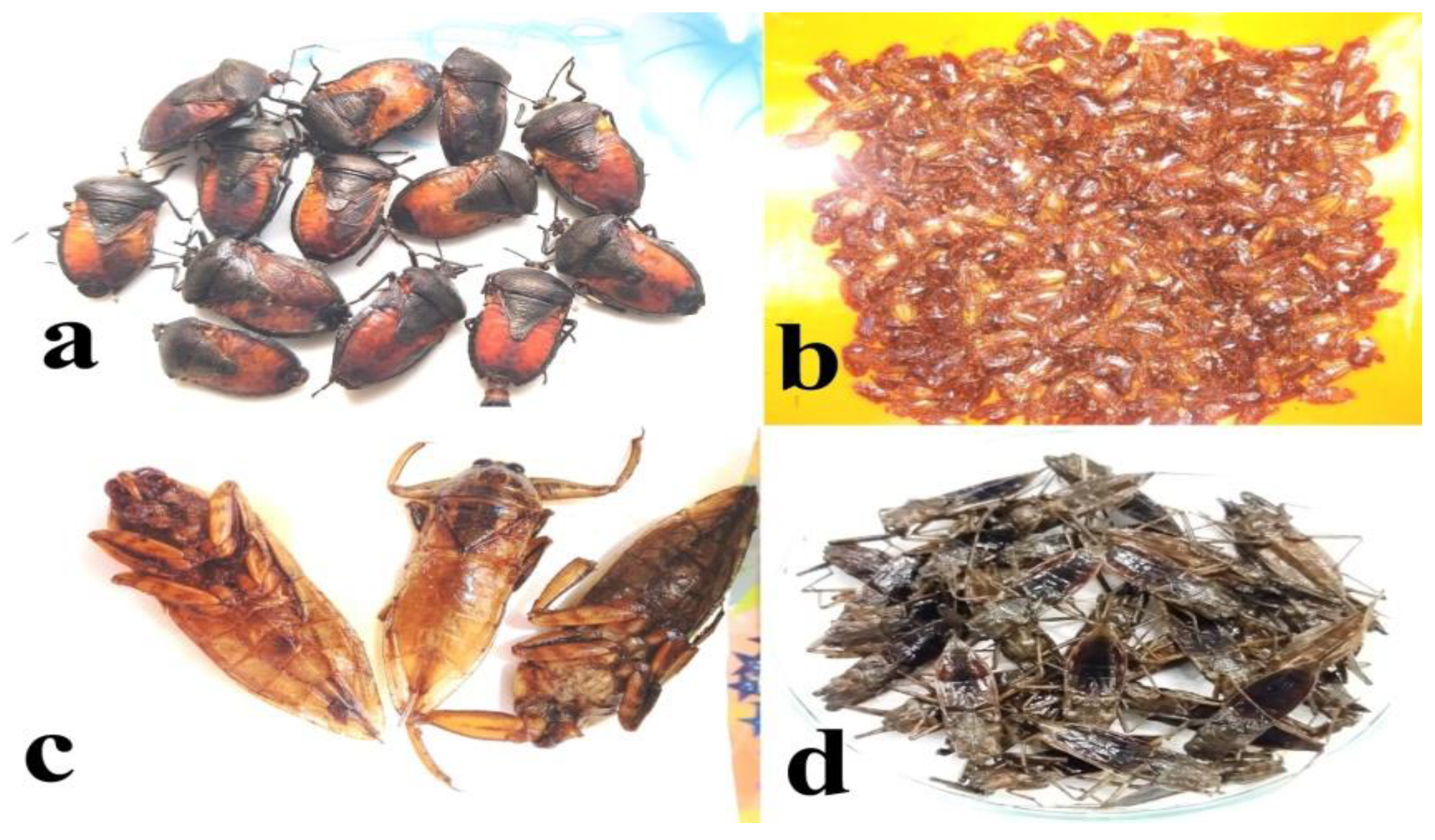

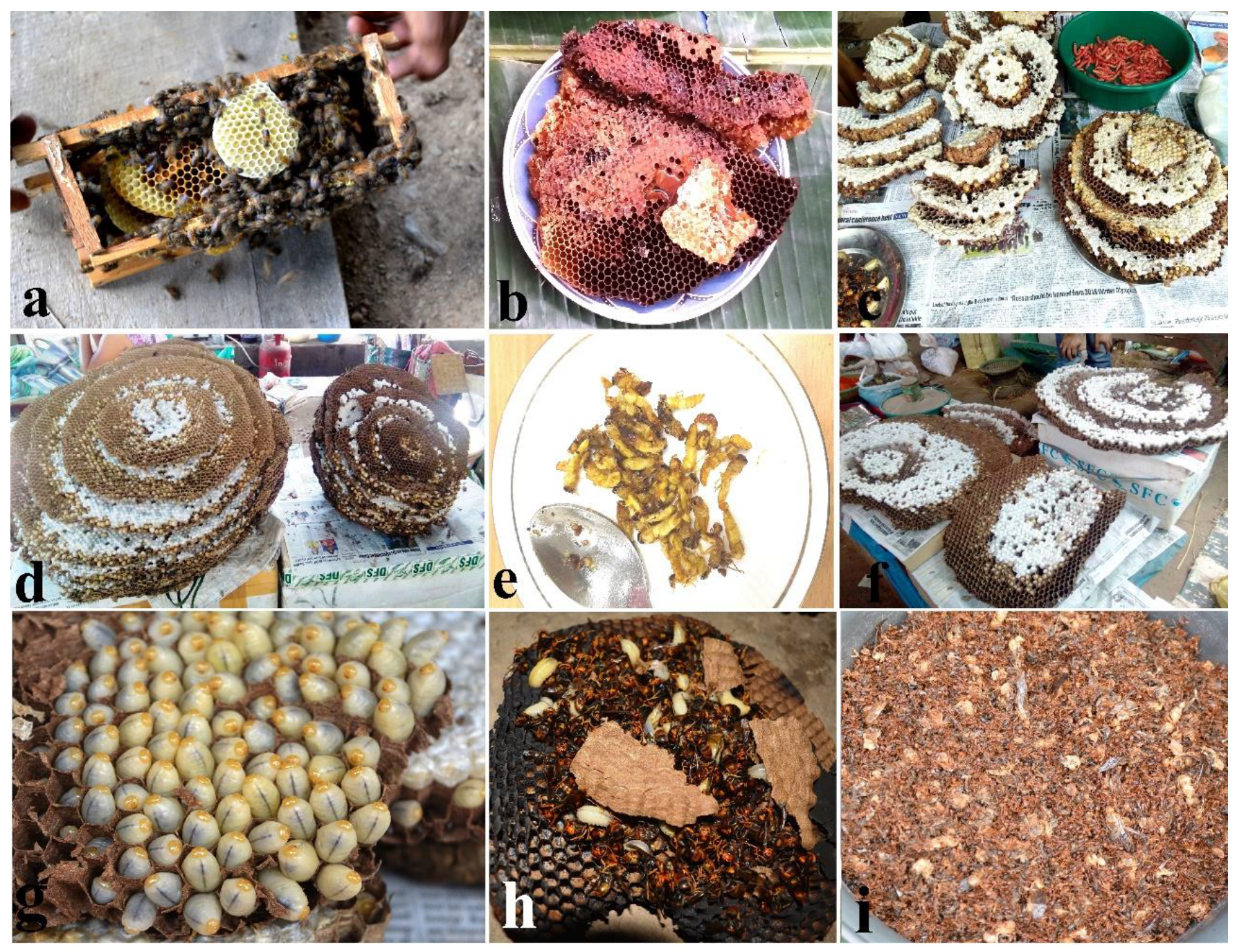
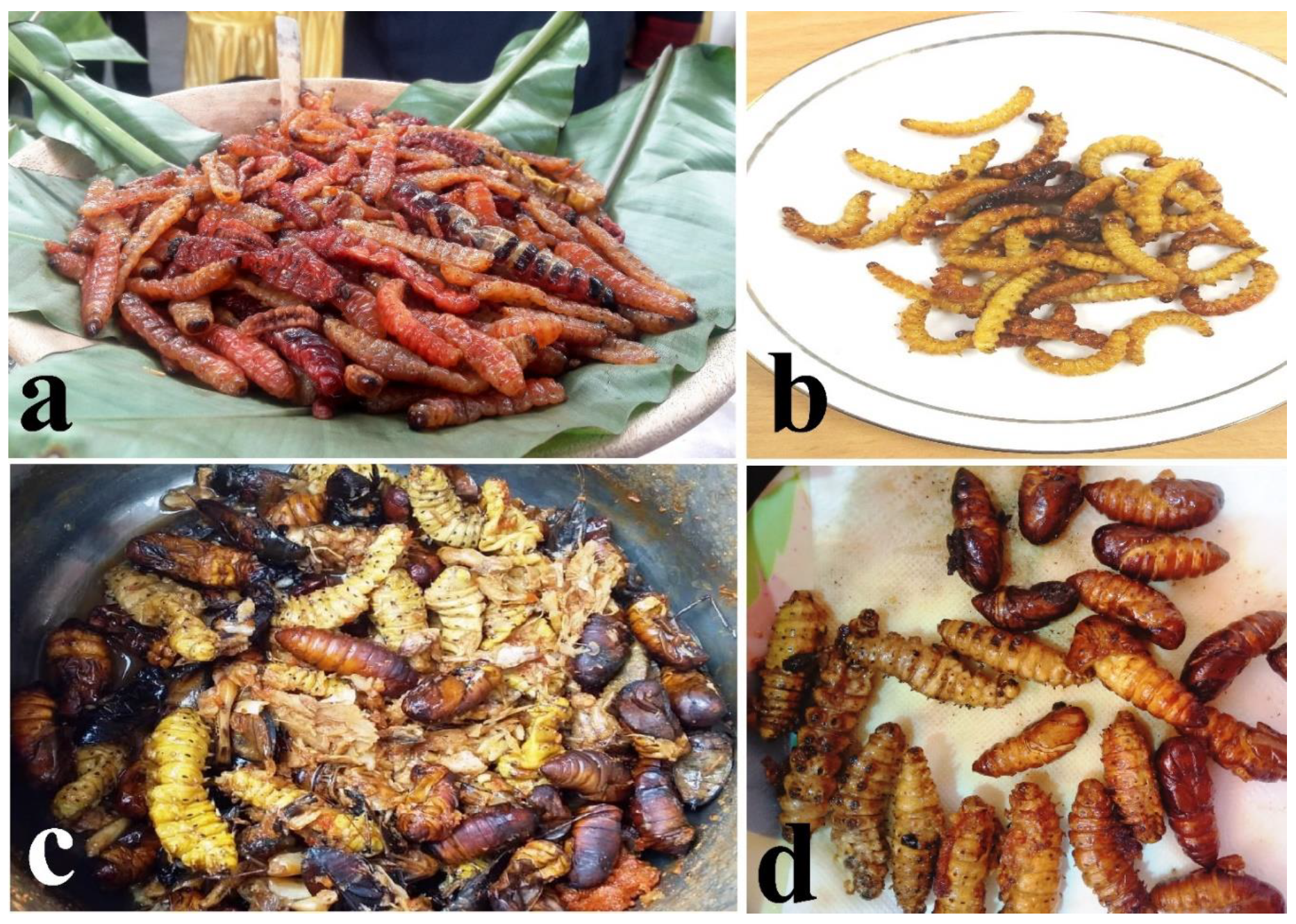
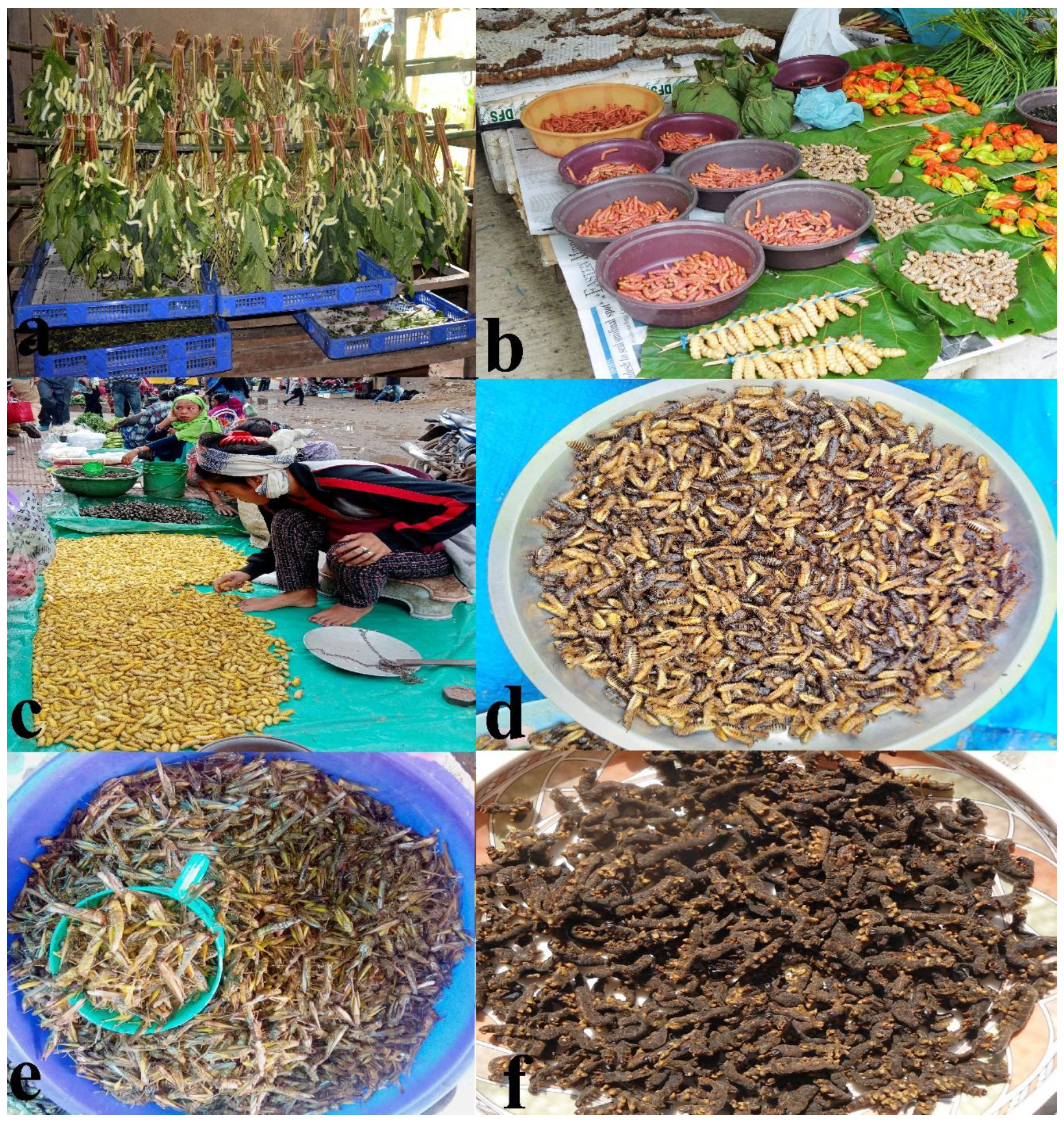
| Gender | Number of Informants |
|---|---|
| Male | 248 (67%) |
| Female | 122 (33%) |
| Age Group | |
| 25–34 | 60 (16%) |
| 25–44 | 58 (16%) |
| 45–54 | 59 (16%) |
| 55–64 | 55 (15%) |
| 65–74 | 57 (15%) |
| 75–84 | 58 (16%) |
| 85–94 | 18 (5%) |
| 95–104 | 5 (1%) |
| Educational status | |
| Below high school | 230 (62%) |
| Above high school | 140 (38%) |
| Informant status | |
| Key informant | 198 (54%) |
| General informant | 172 (46%) |
| Order | Family | Scientific Name | Local Name | Seasonal Availability | Edible Stage | Mode of Consumption |
|---|---|---|---|---|---|---|
| Odonata | Libellulidae | Diplacodes trivialis Rambur | Tukhakupu | July–Nov | nymph | B, C |
| Orthetrum pruinosum neglectum Rambur | Tukhakupu | July–Nov | nymph | B, C | ||
| Neurothemis fulvia Drury | Tukhakupu | July–Nov | nymph | B, C | ||
| Crocothemis servilia servilia Drury | Tukhakupu | July–Nov | nymph | B, C | ||
| Potamarcha congener Rambur | Tukhakupu | July–Nov | nymph | B, C | ||
| Orthetrum sabina sabina Drury | Tukhakupu | July–Nov | nymph | B, C | ||
| Orthetrum triangulare triangulare Sely | Tukhakupu | July–Nov | nymph | B, C | ||
| Pantala flavescens Fabr. | Tukhakupu | July–Nov | nymph | B, C | ||
| Orthoptera | Acrididae | Acrida exaltata Walker | Tsütheku | June–Oct | adult | C |
| Atractomorpha sp. | Anishe | June–Oct | adult | C | ||
| *Choroedocus robustus De Geer | Shenaqhu | June–Oct | adult | C | ||
| Chondracris rosea Serville | Kuprie | June–Oct | adult | RO/TO | ||
| *Gastrimargus africanus africanus Saussure | Tluqhu | June–Oct | adult | C | ||
| Hieroglyphus banian Fabr. | Sapathika | June–Oct | adult | C | ||
| Melanoplus sp. | Yeghutukha | June–Oct | adult | C | ||
| Melanoplus bivittatus Say | Shenaqhu | June–Oct | adult | RO | ||
| Oxya hyla Serville | Naghilithika | June–Oct | adult | C | ||
| *Oxya fuscovittata Marschall | Naghilithika | June–Oct | adult | C | ||
| *Phlaeoba infumata Brunner | Atikha | June–Oct | adult | C | ||
| Gryllidae | Acheta domesticus Linn. | Achuqu | Aug–Nov | adult | C | |
| Gryllus sp. | Ashuko | Sept–Nov | adult | C | ||
| Meloimorpha cincticornis Walker | Petu | Aug–Nov | adult | C | ||
| *Teleogryllus sp. | Amishibachuqu | Aug–Nov | adult | C | ||
| *Teleogryllus occipitalis Serville | Awusho | Aug–Nov | adult | C | ||
| Tarbinskiellus orientalis Fabr. | Awusho | Aug–Nov | adult | C | ||
| *Tarbinskiellus portentosus Lichtenstein | Awusho | Aug–Nov | adult | C | ||
| Gryllotalpidae | Gryllotalpa orientalis Burmeister | Alhaqu | Aug–Nov | adult | C | |
| Tettigoniidae | Mecopoda nipponensis Haan | Kaghalapu | June–Oct | adult | RO/TO | |
| Mecopoda elongata Linn. | Khotsule | June–Oct | adult | RO/TO | ||
| Pseudophyllus titan White | Salhatiti | June–Oct | adult | RO/TO | ||
| *Elimaea securigera Brunner | Anishe | June–Oct | adult | C | ||
| Orthoptera | Tettigoniidae | Tettigonia sp. | Anishe | June–Oct | adult | C |
| Schizodactylidae | *Schizodactylus monstrosus Drury | Awusho | June–-Aug | adult | C | |
| Mantodea | Manitidae | Tenodera sinensis Saussure | Tsukole | July–Sept | adult | RO |
| Hierodula coarctata Saussure | Kupkamichukole | July–Sept | adult | RO | ||
| Isoptera | Termitidae | Macrotermes sp. | Alho | Nov–Dec | adult | C |
| Hemiptera | Aetalionidae | *Darthula hardwickii Gray | Thezü | Sept–Oct | nymph | C, F |
| Belostomatidae | Lethocerus indicus Lepeltier and Serville | Tsungosho | Nov–Jan | adult | C | |
| Cicadidae | Tibicen pruinosa Say | Akoko | May–Nov | adult | C | |
| Dundubia intemerata Walker | Akoko | May–Nov | adult | C | ||
| Dundubia oopaga Distant | Akoko | May–Nov | adult | C | ||
| Pomponia sp. | Cievü | May–Nov | adult | C | ||
| Pycna repanda Amyot and Serville | Cievü | May–Nov | adult | C | ||
| Coreidae | Dalader planiventris Westwood | Akhane | May–July | adult | C | |
| Anoplocnemis phasiana Fabr. | Akhane | May–Aug | adult | C | ||
| Notobitus meleagris Fabr. | Akhane | Aug–Sept | adult | C | ||
| Dinidoridae | Aspongopus nepalensis Westwood | Akhane | Dec–Jan | adult | C | |
| Coridius janus Fabr. | Akhane | May–July | adult | C, CH | ||
| Coridius chinensis Dallas | Akhane | May–July | adult | C, CH | ||
| *Coridius singhalanus Dist. | Akhane | Feb–Mar | adult | C, CH | ||
| Nepidae | Laccotrephes ruber Linn. | Akhane | Oct–Jan | adult | C | |
| Pentatomidae | Chinavia hilaris Say | Akhane | May–July | adult | C | |
| Cyclopelta siccifolia Westwood | Akhane | May–July | adult | C | ||
| Dolycoris sp. | Akhane | April–May/Nov | adult | C, CH, F | ||
| Erthesina fullo Thunberg | Akhane | Aug–Sept | adult | C | ||
| Eurostus grossipes Dallas | Akhane | May–July | adult | RO | ||
| Hemiptera | Pentatomidae | *Udonga montana Distant | Akhane | April–May/Nov | adult | C, CH, F |
| Tessaratomidae | Tessaratoma javanica Thunberg | Akhane | May–July | adult | RO | |
| Coleoptera | Cerambycidae | Anoplophora sp. | Nukuo | Sept–Jan | all | C, RO |
| Batocera rubus Linn. | Akulho | June–Nov | larva, pupa | C | ||
| Batocera parryi Hope | Akulho | June–Nov | larva, pupa | C | ||
| *Batocera rufomaculata De Geer | Akulho | June–Nov | larva, pupa | C | ||
| Orthosoma brunneum Forster | Akulho | July–Nov | all | C, RO | ||
| Chrysomelidae | *Aplosonyx chalybaeus Hope | Akallakulho | Sept–Nov | larva | C | |
| Curcurlionidae | Rhynchophorus ferrugineus Olivier | Akulho | Oct–Nov | all | C | |
| Dytiscidae | Cybister limbatus Fabr. | Azükhanu | July–Nov | adult | C | |
| *Cybister tripunctatus lateralis Fabr. | Azükhanu | July–Nov | adult | C | ||
| *Sandracottus manipurensis Vazirani | Dzübolo | July–Nov | adult | C | ||
| Hydropillidae | Hydrophilus caschmirensis Redtenbacher | Azühpüllau | July–Nov | adult | C | |
| Scarabaeidae | Xylotrupes gideon Linn. | Shushu | June–Aug | adult | RO | |
| Coleoptera | Scarabaeidae | Lepidiota stigma Fabr. | Kolompvu | Aug–Sept | adult | RO |
| *Holotricha sp. | Befu | July–Aug | adult | RO | ||
| Hymenoptera | Apidae | Apis cerana indica Fabr. | Aghui | Whole year | all | R, C |
| Apis dorsata dorsata Fabr. | Ati-i | Sept–May | all | R, C | ||
| Apis dorsata laboriosa Smith | Atukhi | Sept–May | all | R, C | ||
| Apis florea Fabr. | Aku-u | Sept–Feb | all | R, C | ||
| Lepidotrigona arcifera Cockerell | Amgho | Sept–Feb | all | R | ||
| Lophotrigona canifrons Smith | Tyita | Sept–Feb | all | R | ||
| Xylocopa violacea Linn. | Khvukhvu | May–Oct | honey | R | ||
| Formicidae | Oecophylla smaragdina Fabr. | Satghupu | May–July | all | B, C, CH | |
| Vespidae | Parapolybia varia Fabr. | Pughukhi | May–Sept | all | C, F | |
| Polistes olivaceus De Geer | Pighikhi | May–Sept | all | C, F | ||
| Polistes stigma Fabr. | Pughukhi | May–Sept | all | C, F | ||
| *Polistes sp. | Pughukhi | May–Sept | all | C, F | ||
| Provespa barthelemyi du Buysson | Akizu | Sept–Feb | all | C, F | ||
| *Ropalida rufoplagiata Cameron | Awopu | Sept–Feb | all | C, F | ||
| *Ropalida sp. | Awopu | Sept–Feb | all | C, F | ||
| Vespa affinis indosinensis Perez | Akhighü | Sept–Feb | all | C, F | ||
| Vespa auraria Smith | Akhibo | Sept–Feb | all | C, F | ||
| Vespa basalis Smith | Akhitsu | May–Nov | all | C, F | ||
| Vespa bicolor Fabr. | Akhitsu | May–Nov | all | C, F | ||
| Vespa ducalis Smith | Angui | May–Nov | all | C, F | ||
| Vespa mandarinia Smith | Akhighü | Sept–Feb | all | C, F | ||
| Vespa tropica tropica Linn. | Akichekhi | May–Nov | all | C, F | ||
| Vespa soror du Buysson | Akhitsü | Sept–Feb | all | C, F | ||
| **Vespula orbata du Buysson | Akhibo | May–Nov | all | C, F | ||
| Vespula sp. | Akhibo | May–Nov | all | C, F | ||
| Lepidoptera | Cossidae | Cossus sp. | Aphukulho | July–Feb | larva, pupa | B, C |
| Crambidae | Omphisa fuscidentalis Hampson | Akhaukhulo | Aug–Oct | larva, pupa | C, F, ST | |
| Hesperiidae | Erionata torus Evans | Wuchoninga | Sept–Nov | larva, pupa | B, C | |
| Lasiocampidae | Malacosoma sp. | Michekhane ninga | Nov–Dec | larva, pupa | C | |
| Noctuidae | *Pericyma cruegeri Butler | Katsulanga | April–May | larva | C, F | |
| Saturniidae | *Antheraea assamensis Helfer | Muga | Whole year | larva | C | |
| *Antheraea mylitta Drury | Bokori ra | May–July | larva | C | ||
| Samia cynthia ricini Boisduval | Eri | Whole year | larva, pupa | C, F | ||
| Diptera | Tipulidae | Tipula sp. | Pochighoh | Sept–Jan | larva | B, C, F |
© 2020 by the authors. Licensee MDPI, Basel, Switzerland. This article is an open access article distributed under the terms and conditions of the Creative Commons Attribution (CC BY) license (http://creativecommons.org/licenses/by/4.0/).
Share and Cite
Mozhui, L.; Kakati, L.N.; Kiewhuo, P.; Changkija, S. Traditional Knowledge of the Utilization of Edible Insects in Nagaland, North-East India. Foods 2020, 9, 852. https://doi.org/10.3390/foods9070852
Mozhui L, Kakati LN, Kiewhuo P, Changkija S. Traditional Knowledge of the Utilization of Edible Insects in Nagaland, North-East India. Foods. 2020; 9(7):852. https://doi.org/10.3390/foods9070852
Chicago/Turabian StyleMozhui, Lobeno, L.N. Kakati, Patricia Kiewhuo, and Sapu Changkija. 2020. "Traditional Knowledge of the Utilization of Edible Insects in Nagaland, North-East India" Foods 9, no. 7: 852. https://doi.org/10.3390/foods9070852
APA StyleMozhui, L., Kakati, L. N., Kiewhuo, P., & Changkija, S. (2020). Traditional Knowledge of the Utilization of Edible Insects in Nagaland, North-East India. Foods, 9(7), 852. https://doi.org/10.3390/foods9070852




